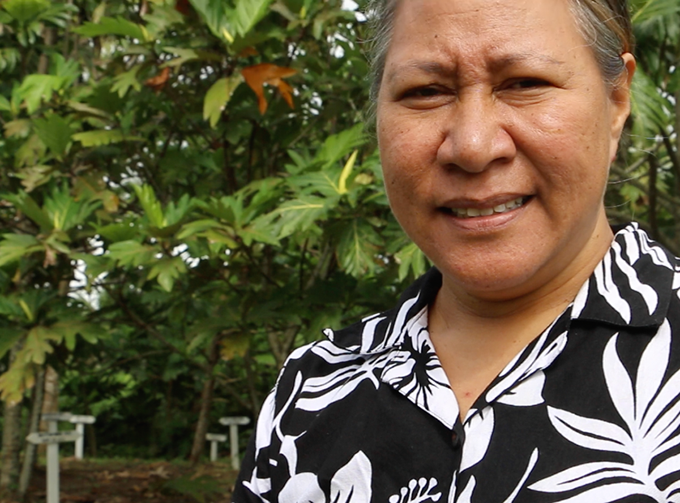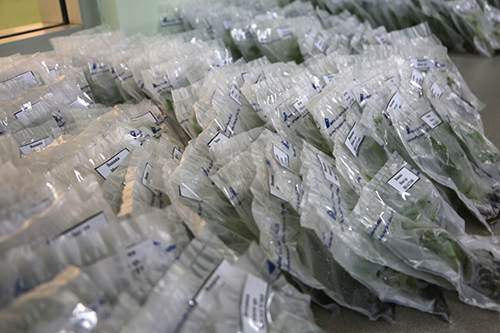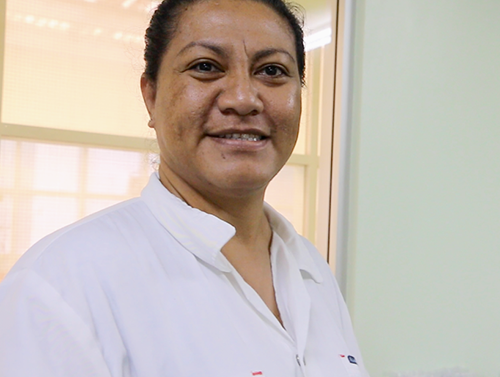AsiaPacificReport.nz

By TJ Aumua in Suva
Severe weather patterns and cyclonic activity have become increasingly hyperactive in the South Pacific with climate change the key contributor.
Communities are faced with the destruction of food crops and are left suffering from food scarcity and malnutrition.
 The Pacific Media Centre team in Fiji was granted access to propagation projects at the Pacific Community (SPC) and its Centre for Pacific Crops and Trees in Suva (CePaCT).
The Pacific Media Centre team in Fiji was granted access to propagation projects at the Pacific Community (SPC) and its Centre for Pacific Crops and Trees in Suva (CePaCT).
Here the issue of climate effects on food sources are being addressed by researchers developing strategies for rapid plant growth and climate resistant crops.

When we arrived at the centre, busy white-coated lab assistants were counting and double-checking more than 1000 banana, sweet potato and swamp taro seedlings which lay in rows across the counters, packed delicately in plastic pockets.
With the assistance of the UN Food and Agriculture Organisation (FAO) these seedlings are one of three batches to be sent to Tuvalu, where the island agriculture is still recovering from the devastation caused by cyclone Pam in 2014.
A total of 6000 seeds will be sent as part of this project.
Fiji itself was hit by category five, tropical cyclone Winston two months ago and as a result the lab has been experiencing frequent power shortages because of damaged infrastructure.
The continued production of seedlings amid these difficulties shows the importance of collaboration between Pacific countries to address crop resilience and food security in the region.

Tissue-culture propagation
Centre Curator Logotonu Meleisea Maqainabete says the seedlings are grown using tissue culture material, a method used for growing mass shrub vegetation.
The tissue culture propagation process is carried out in strict sterile conditions, from the materials used to grow the seeds to the air currents in the packaging labs to ensure viral and disease free plants.
We were present during one of the labs power outages, which disrupt the workflow each time it happens.
Curator Maqainabete told other lab assistants to re-start the packaging process of the seedlings.
“Each time we have a power cut and the power is out for long time we have to start again because the air becomes unsterile. We’ve had about 10 or 11 power cuts this week.”
Stem-cutting research
Unlike tissue culture cultivation used for shrub-like vegetables, the stem cutting technique is being used to encourage growth of tree species.
The process involves cutting branches from a mother-plant and rerooting the cutting in soil.
Plants grown from stem cuttings are more likely to mature faster. But although the method sounds easy, the practical application is far from simple.
The environment of the plants is continuously tested to find what temperature and humidity levels encourage the best growth.

SPC Genetic Resources Coordinator Valerie Tuia, told Asia Pacific Report breadfruit trees, an economical crop for being a staple food source in the Pacific, is the main focus for stem-cutting research in the centre.
Other economical crops being tested are coffee, mango, cocoa and mango.
“Some of these crops flower or produce seeds once a year, and sometimes we get requests for planting material right throughout the year,” says Tuia.
“The idea is, once you work out a system where you are producing material using stem cuttings then you can continue planting and supplying materials right throughout the year.”
Drought resistant crops
The effects of longer periods of drought and frequent bouts of severe weather forces have made it difficult for farmers in the region to grow seasonal produce.
Tuia explains the findings so far, suggesting crops with a combination of plant species have a better chance of surviving drought conditions.
According to the SPC website, assistance from DFAT (Australian Aid) and the International Climate Change Adaptation Initiative (ICCAI), has allowed the Centre for Pacific Crops and Trees to research “climate ready crops”.
These consist of plant species that are able to tolerate drought, salt, high temperature, and waterlogging.
“So we are looking at different approaches on how you can integrate short term crops like leafy vegetables, medium term crops like cassava and taro, and then tree crops like breadfruit or lemon trees,” says Tuia.
“With that approach, models of these crops can be practiced by small scale farmers.”
Elevated cultivation
After cyclonic weather and floods, rubbish and waste products add to the already difficult task of cleaning streets and coastlines.
“Waste materials like bottles and containers are a nuisance,” says Tuia. “So we are looking at ways of using low technology, and recycling these materials to grow vegetables.”
“What you can do is cut the bottom of the plastic bottle to plant any vegetables inside. Sterile the plastic first with hot water and sun dry the soil to kill all the microbes.
“You can then make small hooks and make an apparatus where you can then hang the individual plant containers—this is what we call elevated cultivation.”
The simple but economical strategy means it can be easily adopted, with rural and marginalised communities being able to adapt to it without needing expensive materials.
These mobile plants can be moved in doors so farmers can avoid replanting and starting their crops again in the threat of a cyclone or forced climate relocation.
“Destruction of crops also affects nutrition,” says Tuia. “The price of fresh vegetables and fruit increases after a natural disaster, so this method allows continuous harvesting of crops for anyone.”
Ami Dhabuwala and Pacific Media Watch contributing editor TJ Aumua are in Fiji on a two-week “Bearing Witness” climate change journalism project with the University of the South Pacific.
–]]>







